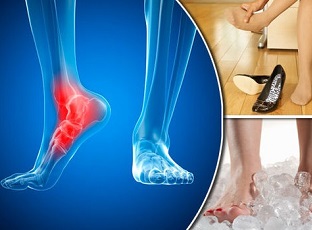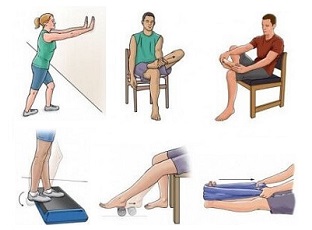- Home
- Diagnosis Guide
- Outer Side Foot Pain
Pain On Outside Of Foot
Written By: Chloe Wilson BSc(Hons) Physiotherapy
Reviewed By: FPE Medical Review Board
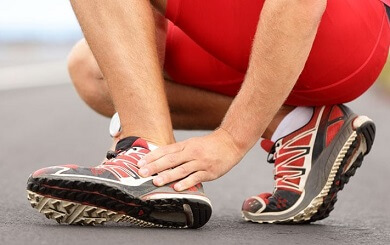
Pain on the outside of the foot, aka lateral foot pain, is a common problem.
There are a number of different structures on the outer side of the foot and problems in any of them can cause pain.
There may be a sharp pain or a dull ache on the outer foot. Symptoms may have come on gradually over time, or developed suddenly with an injury and they may get better with rest or with movement. There may also be some swelling or a lump on the side of the foot.
Thinking about the location and onset of side foot pain can give us a good indication of what the problem is. Here we will focus on pain on the outside of your foot, but if your pain is more on the inner side of your foot, check out the Inner Foot Pain article.
Causes Of Lateral Foot Pain
There are a number of different things that can cause pain on the outside of the foot. Here we will start by looking at the most common causes, then we'll go on to look at the diagnosis process and the best treatment options for lateral foot pain.
1. Peroneal Tendonitis
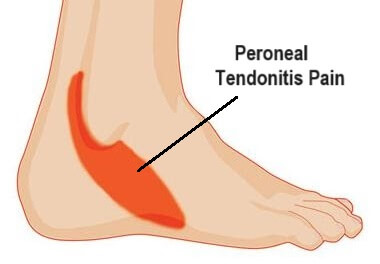
The most common cause of pain on the outside of the foot is peroneal tendonitis. This is where there is inflammation and degeneration in the peroneal tendon that runs down the back of the ankle and along the outer side of the foot.
Lateral foot pain from peroneal tendonitis is usually caused by repetitive tension through the tendon from frequent overuse e.g. long distance running, abnormal foot position, muscle imbalance, or an ankle injury.
Typical symptoms of peroneal tendonitis include a gradual onset of lateral foot pain that gets worse with activity and eases with rest. The outer foot pain is often worse when you first get up or when you twist your foot inwards.
Pain on the outside of the foot from peroneal tendonitis is usually treated with a combination of RICE (rest, ice, compression & elevation), medication, rehab exercises, orthotics and physical therapy.
You can find out loads more about peroneal tendonitis, how it causes pain on outside of foot and how to treat it in the peroneal tendonitis section.
2. Ankle Sprains
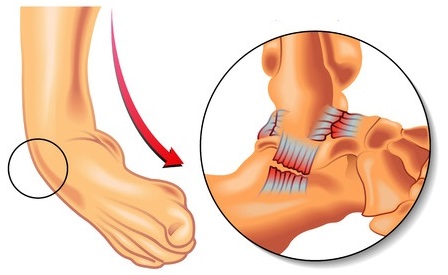
The most common cause of lateral foot pain near the ankle following an injury is a ligament sprain. Ligament tears account for 85% of all ankle injuries.
Ligaments are tough, fibrous bands of tissue that support joints, and the ankle ligaments are the main stabilising structures of the foot.
The ankle ligaments are very strong but if they are suddenly stretched too far, then they can tear. This typically happens when you roll over on your ankle and it twists inwards sharply. Ankle sprains are common in sports, when walking on uneven ground or when wearing high heels.
Pain on the outside of the foot from a ligament sprain is usually felt immediately at the time of injury. Symptoms will depend on how much damage there is to the ligament, ranging from a grade 1 ankle sprain where only a few of the ligament fibres are torn, to a grade 3 rupture where the ligament tears completely. There is often some bruising and swelling on the outer side of the foot as well as ongoing instability and weakness.
You can find out all about the causes, symptoms and how to treat instability and pain on the outside of the foot from ligament injuries in the ankle sprain section.
3. Cuboid Syndrome
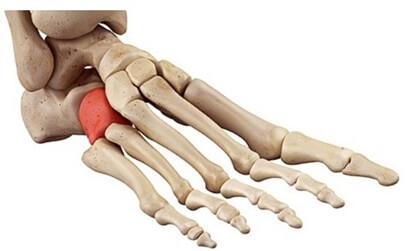
Cuboid syndrome is a common cause of ongoing lateral foot pain. It develops when one of the small bones on the outer side of the foot gets shifted out of position, typically following a twisted ankle or with repetitive jumping or running.
Cuboid syndrome causes pain down the outer side of the foot which may extend across the top of the foot and into the toes. The lateral foot pain typically gets worse when weight-bearing, especially first thing in the morning, when walking on uneven ground or quickly changing direction, and may cause you to limp.
There is often weakness in the foot with cuboid syndrome making it difficult to push-off properly when walking, running or jumping.
Cuboid syndrome is particularly difficult to diagnose and often goes undetected, causing the pain on the outside of the foot to persist for months, despite treatment. Successful treatment requires a combination of rehab exercises and joint manipulation to relocate the cuboid bone back into the correct place.
You can find out all about the causes, symptoms and treatment options and how to avoid ongoing lateral foot pain in the Cuboid Syndrome section.
4. Fractures
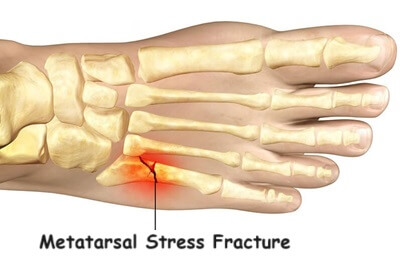
A common cause of outer foot pain in athletes, particularly in adolescents, is a fifth metatarsal fracture.
There are lots of different types of fifth metatarsal fracture, depending on the location of the break, which are all treated slightly differently.
- Avulsion Fractures: occur at the proximal end of the bone, near the cuboid bone. They are typically caused by sudden twisting injuries and are the most common type of metatarsal fracture causing swelling and pain on outside of foot. Aka Pseudo Jones Fracture
- Jones Fractures: occur in a small area, slightly further down the metatarsal bone in what is known as the watershed area. This small area has a very limited blood supply so healing is often compromised, meaning surgery is often necessary
- Stress Fractures: small break in the metatarsal shaft usually caused by repetitive overloading in sports involving lots of running or jumping, sudden increases in activity levels or switching training surfaces e.g. from grass to concrete.
- Dancer's Fractures: a diagonal break in the shaft of fifth metatarsal bone usually due to forced twisting or awkward landing
Typical symptoms of fifth metatarsal fractures include lateral foot pain that gets worse with activity, localised swelling and tenderness. Walking is often affected and you may not be able to take any weight through your foot.
You can find out all about the common causes, symptoms, diagnosis and treatment options in the Fifth Metatarsal Fracture section.
Other Possible Causes Of Outer Foot Pain
There are a few other possible causes of pain on the outside of the foot:
- Foot Bunions: deformity at the toe joints can causes pain on outside of foot by the big toe (hallux valgus) or the little toe (bunionette). The toe starts to shift inwards causing a hard lump and outer foot pain by the toes and the toes may end up crossing over each other. Genetics, footwear, altered foot biomechanics and arthritis are common causes. Find out more in the Foot Bunions section.
- Corns & Calluses: cause pain on the outside of the foot that is accompanied by thick, hard, raised areas of skin. Calluses cause thick, hardened skin, and are usually painless. Corns result in small, circular areas raised skin, yellow/white, that are often painful. They are usually caused by excessive friction on the skin from tight shoes, foot deformities and aging. Find out more about causes and treatment in the Corns & Calluses section.
- Foot Tendonitis: inflammation or degeneration in one of the foot tendons. Posterior tibial tendonitis causes inner foot pain, anterior tibial tendonitis causes pain across the front of the foot, extensor tendonitis causes pain on top of the foot and achilles tendonitis causes pain at the back of the foot. Tendonitis is usually caused by repetitive overuse, altered foot biomechanics, foot injuries or certain medical conditions. Find out more in the Foot Tendonitis section.
Diagnosing Lateral Foot Pain
Any new incidence of pain on the outside of the foot that doesn't settle down within a few days should be assessed by your doctor. At your appointment the doctor will:
- Take A History: Asking lots of questions to find out e.g. when & how the pain on outside of foot started, how it's behaved since, any other symptoms, anything that makes it better or worse and pain severity
- Examine Your Foot: Looking at the appearance, movement, strength, functional activities involving the foot e.g. walking, special tests e.g. to look at integrity of the ligaments
- Order Further Investigations: If they feel there may be bone damage you will be sent for an xray. Soft tissue injuries may require ultrasound, CT or MRI imaging. You may also be sent for a blood test
- Treatment: Once the doctor has identified what is causing your pain on the outside of your foot, they will advise you on appropriate treatment e.g. exercises, physiotherapy, orthotics or rest.
If you have injured your foot, have severe lateral foot pain, are unable to walk, have lost sensation in your foot, or your foot has changed colour, see your doctor immediately.
Treating Pain On Outside Of Foot
The best treatment for lateral foot pain will usually involve a combination of:
- Rest Ice Compression Elevation: Generally, the best place to start is with RICE - a combination of resting from aggravating activities, regularly applying ice, wearing a compression bandage to reduce swelling and support the foot and elevating the leg to help reduce swelling. When used properly, RICE helps to reduce further damage, speed up healing and reduce outer foot pain and inflammation. FIND OUT MORE >
- Physical Therapy: As well as advising you on rehab, your physical therapist may also carry out other treatments such as ultrasound or acupuncture for pain on outside of foot. They can also advise on orthotics and whether special shoe insoles will help
- Exercises: After a few days, any swelling should have started to go down and in most cases you can start some gentle foot and ankle exercises. This helps you to regain the full range of movement and strength, aids healing by bringing fresh nutrients to the injured area and puts the right stresses and strains through the soft tissues so that they heal fully in the correct position. People are often unsure what exercises will help and worry about overdoing things so it is really important to get the right advice. FIND OUT MORE >
- Crutches: with severe pain on outside of foot, it may help to use crutches for a few days to take the weight off the foot. Check out our top tips on getting up and down stairs on crutches.
- Surgery: In some cases, foot and ankle surgery may be advised for your lateral foot pain if other treatment methods have failed
You can find out more about specific treatment techniques for each of the different causes of pain on outside of foot by reading the full articles about your specific foot problem.
What's Causing My Side Foot Pain?
So as you can see there are lots of possible causes of lateral foot pain each of which present slightly differently:
- Pain on Outside of Foot: ligament tear (sprain), stress fracture, peroneal tendonitis, cuboid syndrome, Jones fracture, avulsion fracture, dancers fracture
- Pain on Inner Side of Foot: bunion, posterior tibial tendonitis
- Hard, Thickened Skin: corns and calluses
- Twisted Foot Inwards: ligament sprain, cuboid syndrome, Jones fracture, avulsion fracture, dancers fracture
- Ongoing Pain after Ankle Sprain: cuboid syndrome
- Pins & Needles or Numbness: nerve problem
- Pain Worse When You First Get Up: cuboid syndrome
- Abnormal Toe Position or Hard Lump: bunions
- Difficulty Standing On Tiptoes: posterior tibial tendonitis, cuboid syndrome
If you have noticed a lump on the side of your foot which may or may not be painful, check out the Lump On Side Of Foot article.
If you are having trouble working out what is causing the pain on the outside of your foot, or your foot pain is more widespread, visit the foot pain diagnosis section for help working out what is going wrong.
You may also be interested in the following articles:
Related Articles
Page Last Updated: 26th November, 2024
Next Review Due: 26th November, 2026
